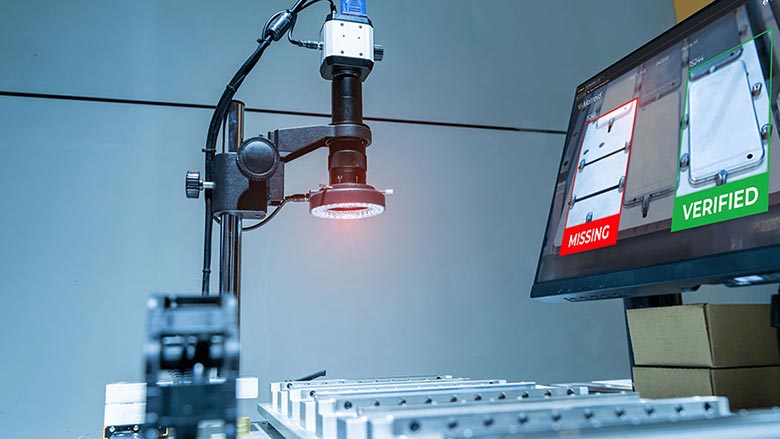



Manufacturers nowadays prioritize accuracy and efficiency. Traditional quality control methods can’t keep up with rapid production demands. Machine vision systems for quality control offer a solution. They automate inspection for defects and dimension verification through image analysis. This overview explores machine vision components, integration strategies, and future trends driving this field.
The Basics of Machine Vision Systems in Quality Control
Machine vision technology enables automated quality control in high-speed manufacturing. It combines hardware and software to capture and analyze images with superhuman speed and precision. The systems identify defects, verify product dimensions, and assess overall quality through detailed image inspection.
High-resolution cameras are central to machine vision systems. They act as the eyes, capturing detailed product images on the production line. Camera specifications like resolution, frame rate, and sensor type match each manufacturing process. This captures high-quality images crucial for accurate analysis.
Getting a good picture is key for machine vision quality checks. Once a product image is captured, special computer programs examine it closely. These programs have smart rules to identify any flaws or issues with the product. The software looks at the image and compares it to set quality standards. Then it can decide if the product passes or fails.
To get the best images for inspection, machine vision systems use careful lighting setups. The right lighting makes it easier to see important details or defects when checking product quality. Techniques like bright field or back lighting might be used, depending on what works best for inspecting that specific product.
Using machine vision for quality control is an advanced technology that allows checking products without contact, quickly. This improves product quality while also making manufacturing smoother. By using these systems in the right way, manufacturers can meet and exceed the tough requirements of today’s production lines.
Key Components of Machine Vision Systems for Quality Assurance
Machine vision quality systems have core parts that are crucial for working well and efficiently. First is the imaging device or camera. Choosing the right camera means considering its resolution and frame rate to match the manufacturing speed and level of detail needed for inspections. The type of sensor, like CMOS or CCD, also affects image quality and finding defects.
Lighting is the second major part of machine vision systems for quality control. It plays a key role in capturing clear images with visible details. There are different lighting setups used. Bright field lighting shines light directly on the product to show surface details and defects. Back lighting creates an outline of the product shape and outline. The lighting setup depends on what details or defects need to be seen.
The most important part of the system is the image processing software. It uses special math to examine images in real time. The software compares each product image to standards and models. It can find issues like wrong dimensions or surface problems. This software can quickly and accurately identify quality issues.
The last part is how the machine vision system reports its findings. It might flag defective products to remove. Or it could connect to manufacturing systems to make decisions based on the inspection results. This final step ensures that insights from image analysis get acted on right away. This closes the loop for quality control. Together, these parts form a system that helps manufacturers maintain high product quality during fast production.
Future Trends in Machine Vision Systems for Quality Control
Machine vision is rapidly progressing thanks to artificial intelligence and deep learning. The systems can autonomously study massive datasets and learn. This capability helps them detect even tiny defects more accurately, boosting quality assurance.
Robotics integration is another big step. Combining robotic arms and machine vision enables fully automated inspections. This enhances speed and precision, reduces human errors, and ensures consistent high quality output across production lines.
New imaging innovations like hyperspectral and 3D scanning expand machine vision’s scope. Hyperspectral imaging reveals chemical composition changes, while 3D scans capture intricate shape and surface details. These advancements allow detecting a wider range of defects, making the systems indispensable for quality control. Quality control in manufacturing is crucial. Machine vision systems help ensure top-notch quality standards. These advanced systems play a key role in automated quality control.
Conclusion
Machine vision systems are essential for achieving optimal quality and efficiency in manufacturing. This overview discussed their key components, smart integration methods, and visionary trends driving their adoption. Strategically incorporating machine vision systems elevates manufacturing precision and streamlines operations, making them invaluable in today’s fast-paced production environments.
Implementing machine vision systems involves initial costs and specialized expertise. However, long-term benefits like improved defect detection and reduced manual inspection make a strong case for adoption. Manufacturers can overcome challenges through strategic partnerships and continuous learning, ensuring successful deployment and sustained efficiency of these systems.
Pre-shipment inspection is going through big changes. Machine vision systems are getting better at checking products. These systems use computers, cameras, and robots. They can spot mistakes that people miss. Technology is helping companies make sure their products meet high standards. Using machine vision can give companies an edge over competitors. It helps make products with great quality and keeps operations running smoothly. Companies that use machine vision will do well in the future.